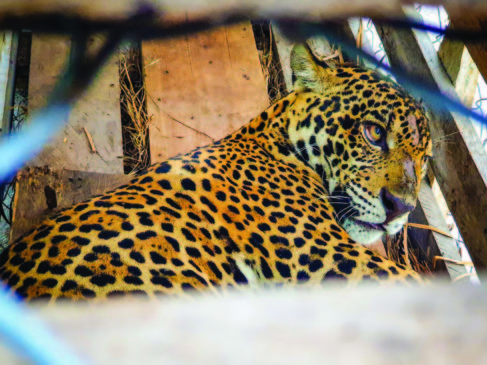…says persons can be fined G$2M for trapping protected animals
The Guyana Wildlife Conservation and Management Commission has confirmed that it took possession of the young female jaguar which was being held at Lima Sands, Essequibo Coast, Region Two (Pomeroon-Supenaam). The jaguar was captured by a Lima Sands resident, Marvin Calvan, on May 22, 2019.

The official who spoke with Guyana Times International on Tuesday confirmed that the country’s national animal was collected by the Commission. In a subsequent statement to the media the Guyana Wildlife Conservation and Management Commission (GWCMC) stated that the GWCMC took custody of the jaguar after consultation with Calvan and his sister. The Commission noted that the jaguar was moved to a cage and the trap was removed and destroyed. The Commission noted that a sample of blood was taken from the animal which has since been released. GWCMC used the opportunity to remind the public that under Regulation 4 (7) of the Wildlife Conservation Management and Sustainable Use Regulation 2019, the jaguar is a protected species.
Additionally, the Commission also stated that Under Section 69 of the Wildlife Conservation and Management Act 2016, it is an offence to have wildlife in possession or to display to the public without the necessary authorisation. Any person who violates this will be liable to pay a fine of G$750,000 to G$2 million and face imprisonment of up to three years.
Questions about the whereabouts of the jaguar came into disrepute after the State-owned newspaper published an article in which it posited that imposters might have collected the animal.
Meanwhile, Calvan had told Guyana Times International that he took special care to ensure that the animal was not harmed. He explained that it was necessary to capture the jaguar as it was eating the livestock of farmers in the community.
According to the Regional Democratic Council of Region Two (Pomeroon-Supenaam), the trap consists of two sections with a small area to hold the bait, which was a live dog; the other section traps the beast.
Between the two compartments is a trap door, which is held opened by twine. It is triggered shut when the animal enters the cage to approach the dog.
“When the oversized cat steps on this twine, the door falls shut, locking the cat inside and cannot be pushed open from the inside. All this time the bait dog is safely in its compartment,” the Regional Administration explained in a Facebook post.
However, the post sparked much outrage on social media, after it was revealed that the owner was charging persons to see the animal, which was said to be in distress. The Regional Executive Officer (REO), Denis Jaikarran, also paid to see the jaguar in a cage. Adults were being charged G$100 while children, G$60.
The Guyana Government has signed a Memorandum of Understanding (MoU) with the Panthera Corporation, aimed at conserving jaguars.
Founded in 2006, Panthera is an organisation devoted exclusively to preserving wild cats and their critical role in the world’s ecosystems.
The jaguar is the third-largest feline in the world, and the largest in the Western Hemisphere.
Globally, jaguar populations are on the decline mainly due to the loss of habitat and conflict with people. As a result, these animals are listed as a “near threatened” species by the International Union for Conservation of Nature (IUCN).
The jaguar is protected by the Wildlife Conservation and Management Act 2016 which states that the collecting, holding in captivity, hunting, killing, or otherwise molesting “protected” species is prohibited.
Only recently, the Government was forced to launch an investigation into the alleged killing of a jaguar during a hunting expedition in Guyana.
A photo of the dead jaguar began circulating on social media and had sparked debates about the need to protect this endangered species of animal.



